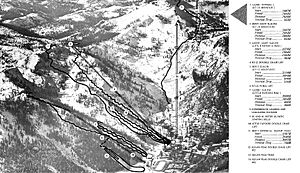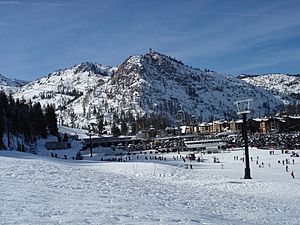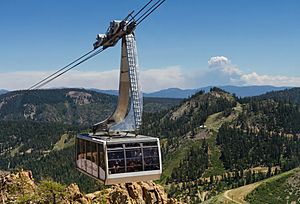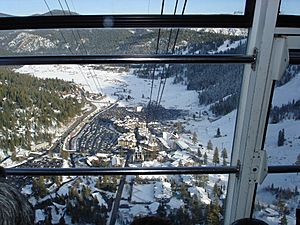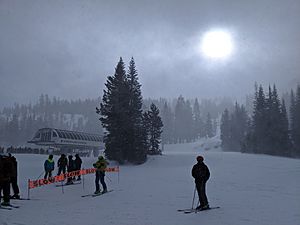Squaw Valley Ski Resort facts for kids
Quick facts for kids Squaw Valley Alpine Meadows |
|
|---|---|

The Village at Squaw Valley, July 2007
|
|
| Location | Squaw Peak Placer County, California |
| Nearest city | Truckee, California Reno, Nevada |
| Coordinates | 39°11′46″N 120°14′06″W / 39.196°N 120.235°W |
| Vertical | 2,850 ft (870 m) |
| Top elevation | 9,050 ft (2,760 m) |
| Base elevation | 6,200 ft (1,890 m) |
| Skiable area | 4,000 acres (16.2 km2) |
| Runs | 177+ |
| Longest run | 3.2 miles (5.1 km) Mountain Run |
| Lift system | 30 |
| Lift capacity | 58,000 per hour |
| Terrain parks | 3 |
| Snowfall | 450 in (1,140 cm) |
| Snowmaking | Yes |
| Night skiing | No |
Squaw Valley Ski Resort, once known simply as Squaw Valley, was the special place that hosted the 1960 Winter Olympics. It is located in Olympic Valley, California. This huge ski resort covers about 3,600 acres (15 km2) of land. It has 30 chairlifts and the only funitel (a special type of cable car) in the United States.
Squaw Valley is the second-largest ski area near Lake Tahoe. In 2012, it joined with Alpine Meadows. Together, they offer access to 6,200 acres (25 km2) of skiable terrain. They have 43 lifts and more than 270 trails. About 600,000 skiers visit the resort each year.
The resort is found northwest of Tahoe City in the Sierra Nevada mountains. Its base is at 6,200 ft (1,890 m) high. The highest point is 9,010 ft (2,750 m) at Granite Chief. Squaw Valley gets a lot of snowfall, averaging 450 in (1,140 cm) every winter. The Squaw Valley Aerial Tramway takes visitors up 2,000 ft (610 m) to an elevation of 8,200 ft (2,500 m). The resort also hosts many fun events in the summer.
In August 2020, the owners decided to change the resort's name. The word "squaw" is an offensive term. They promised to remove it by summer 2021.
Contents
History of Squaw Valley
A former ski star named Wayne Poulsen bought the first 2,000 acres (8.1 km2) of Squaw Valley Ski Resort. He bought it from the Southern Pacific Railroad. Poulsen had skied in the area before. In 1931, he came in third at an Olympic tryout in Tahoe City.
Soon after, Poulsen met Alex Cushing, a lawyer from Harvard. Cushing brought money and important connections to the project. He had fallen in love with Lake Tahoe in 1946. After a disagreement, Cushing took control of the project. He became the chairman of Squaw Valley Ski Corporation. The resort opened in 1949. Cushing remained its chairman until he passed away.
Cushing designed the resort like famous European ski spots. He put a swimming pool, ice rink, and restaurants on the mountain. This was different from most U.S. resorts that kept these at the base. His ideas also brought new lift technology to the U.S. When Squaw Valley opened, its Squaw One lift was the longest double chairlift in the world.
Hosting the 1960 Winter Olympics
Squaw Valley became very famous after hosting the 1960 Winter Olympics. This was thanks to Alex Cushing's hard work. At first, Innsbruck, Austria, was expected to host the Olympics. But in 1955, Cushing convinced the International Olympic Committee in Paris. He showed them a small model of his planned Olympic site.
The 1960 Winter Olympics were the first to be shown live on TV. Millions of people could watch the games as they happened. This event showed that U.S. skiing was becoming as good as European skiing. Squaw Valley's readiness for the games proved that U.S. ski resorts had world-class facilities.
Ski Races and Accidents
Squaw Valley hosted World Cup races in 1969. These included four technical events: slalom and giant slalom for men and women. American skier Billy Kidd won the men's slalom. The 1969 season had a record amount of snow. More than eight feet (2.4 m) of new snow caused the downhill races to be cancelled.
After 48 years, women's technical races returned in 2017. Mikaela Shiffrin from Colorado won both events.
In 1978, Squaw Valley had a very sad accident. On a stormy day, the Aerial Tram came off one of its cables. It dropped 75 feet (23 m) and then hit another cable. This caused severe damage to the car. Four people died, and 31 were injured.
Changes in Ownership
In November 2010, a company called KSL Capital Partners bought Squaw Valley. In September 2011, Alpine Meadows Ski Resort and Squaw Valley Ski Resort announced they would join together. This merger brought the two popular ski areas under the same management.
A year later, they officially merged under a new company. This new company operates as one, offering joint lift tickets and single season passes. Free shuttles connect the two locations. However, each resort still keeps its own unique feel. In 2017, KSL Capital teamed up with another company to form Alterra Mountain Company. This company then became the main owner of Squaw Valley.
In 1960, during the VIIIth Winter Olympic Games, Squaw Valley was named a California Historical Landmark. A marker was placed there. It honored 100 years of organized skiing in the Sierra Nevada mining towns.
Chairlifts and Terrain
Squaw Valley has many different chairlifts to take skiers up the mountain. They are divided into lower mountain and upper mountain lifts.
Lower Mountain Chairs (Elevation 6200')
Upper Mountain Chairs (Elevation 8200')
Mountain Slopes
The ski slopes at Squaw Valley face different directions:
- North: 50%
- East: 40%
- West: 2%
- South: 8%
Snowfall at Squaw Valley
Squaw Valley often gets over 500 inches of snow each year! This chart shows the total snowfall for several ski seasons.
Connecting Squaw Valley and Alpine Meadows
Squaw Valley Ski Holdings, LLC wants to connect Alpine Meadows (ski resort) with a "Base-to-Base" gondola. This gondola would link the two resorts. The resort owners need permission from local land managers. These include Placer County and the Tahoe National Forest. They are currently studying how the project might affect the environment.
Some groups, like Sierra Watch and the Sierra Club, worry about the gondola. They think it could harm the Granite Chief Wilderness area. In July 2019, Sierra Watch and another group filed a lawsuit. They challenged Placer County's approval of the gondola.
In January 2020, the United States Forest Service approved a route for the gondola. This route crosses federal lands. In February 2020, the groups dropped their lawsuit. This happened after Squaw Valley promised to take steps to protect the Sierra Nevada yellow-legged frog. This frog is an endangered species. The approved gondola will cross private land owned by Troy Caldwell, called White Wolf Mountain. Caldwell supports the gondola project.




